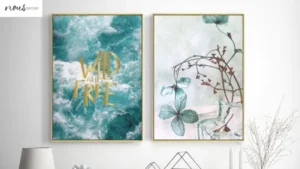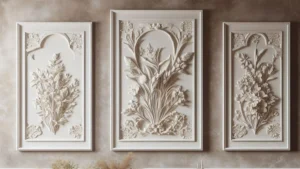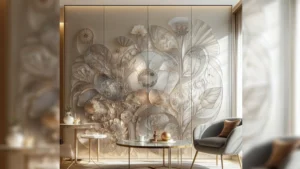At some point in our lives, we’ve all stood in front of a blank wall and wondered How to Arrange Wall Art. While there are countless exterior and interior design options available, wall art is one of the easiest and most effective ways to transform any space.
Whether you want to create an art gallery for a home office or sprucing up your living room, arranging art can feel overwhelming without the right approach. That’s why we’re here to help you master the art of arranging art.
With a few simple tips and tricks, you can create a stunning gallery wall that perfectly reflects your personal style. From choosing the right spot for your artwork to playing with different arrangement styles, we’ll guide you through every step of the process.
With our expert advice, not only will you learn how to arrange pictures on a wall beautifully but also express who you are and what inspires you. So let’s get started on creating a masterpiece with Nousdecor!
Takeaways
- Arranging wall art is a creative endeavor that can transform your living spaces. Wall art serves as the focal point of a room, and the way you go about arranging it can greatly impact the overall ambiance.
- When choosing wall art, consider the subject matter, color schemes, and styles that resonate with your decor.
- The process of placement and layout involves decisions about gallery walls, grids, and symmetry, with the ultimate goal of achieving visual balance and effective composition.
- Lighting and accessories can be your allies in accentuating wall art. Think about how accent lighting and complementary decor can enhance the display.
- To add a personal touch, explore options like DIY art or custom art to make your space uniquely yours.
- In conclusion, wall art is not just decoration; it’s a means of self-expression that, when skillfully arranged, can breathe life into your living areas.
How to Arrange Wall Art? with 5 Steps
Arranging art on a wall following an art decor guide can transform a blank wall into a stunning display of art that enhances the overall ambiance of a wall space.
- When considering the wall to arrange photos and art, consider the room used for hanging your art such as a fireplace or a main seating area like a sofa. This as well as matching art to your room’s color scheme will ensure that the art pieces catch the eye and create a harmonious flow.
- Creating a focal point with a statement piece can be done by choosing a larger piece or more intricate piece that stands out from the rest.
- Balancing colors, sizes, and shapes is also crucial. Mixing different sizes and shapes of art pieces can create visual interest and dynamism.
- Playing with different arrangement styles such as symmetrical or asymmetrical layouts can provide a unique touch to your wall.
- Lastly, to hang artwork correctly and safely, make sure to measure the space and mark the spots on the wall before hammering nails or using adhesive hooks. Additionally, consider using picture-hanging wire or D-rings for added stability.
By following these steps, arranging art and hanging pictures on a wall can become a creative and enjoyable process with an end result that can impress any guest of yours.
Choosing the right wall for hanging art pieces
Find the perfect kind of wall for your beloved collection with the right wall choice. Before you lay out your art on your wall, consider its texture, lighting, size of the wall, and wall color. Wall texture can add an interesting element to your creative wall arrangement.
- A rough wall surface can create a rustic feel while a smooth surface can provide a sleek backdrop. Lighting is also crucial in showcasing your pieces. Natural light can help highlight colors, while artificial light can create dramatic effects.
- Your personal style and cultural significance should also be taken into account when choosing a wall for your art collection. Putting artwork on view from different cultures can add diversity and interest to your home decor.
Incorporating all these elements will help you choose the ideal drywall for your collection, creating a stunning look on any walls of your home and transforming your office with inspiring office decor.
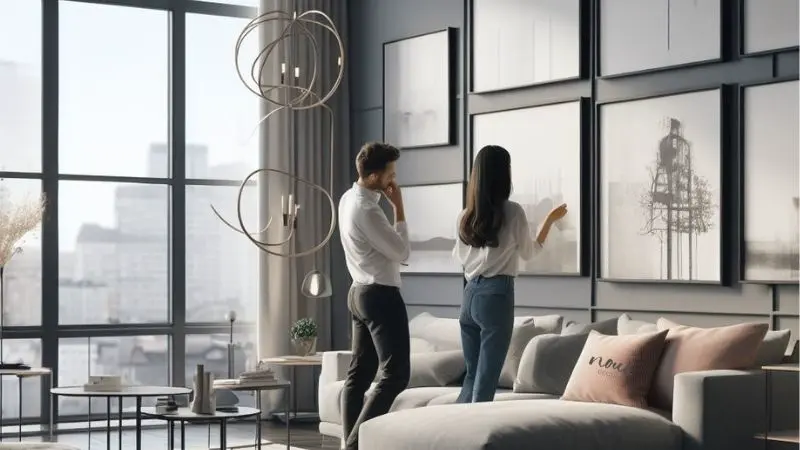
Hang Art to Create a Focal Point with a Statement Piece
A statement piece is the perfect addition to any wall decor view, as it immediately captures the viewer’s attention and sets the tone for the rest of the collection. When choosing a statement piece, consider mixing textures and incorporating lighting elements to add depth and interest.
- Textures are an important part of any scheme, especially when it comes to wall art. By mixing different textures, you can create a visual interest that draws people in and keeps them engaged.
- For example, you might choose a statement piece made from metal or glass to contrast with softer materials like fabric or homemade canvas prints.
- Adding lighting elements such as spotlights or sconces can also help draw attention to your centerpiece and emphasize its unique qualities.
Incorporating a statement piece into your wall arrangement is just one step in mastering the art of arranging art. In our next section, we’ll explore how to balance colors, sizes, and shapes for a cohesive look that ties everything together seamlessly.
Balancing Colors, Sizes, and Shapes
Now it’s time to bring your wall art arrangement to life by balancing colors, sizes, and shapes for a cohesive and visually stunning view that will impress anyone who sees it.
- One way to achieve balance is by mixing textures in your artwork. For example, you can choose one dominant color in your space and incorporate pieces that feature its opposite on the color wheel.
- Using frames creatively can also help you achieve balance in your wall art. Mix and match different frame styles and materials for an eclectic look, or stick with uniform frames for a more streamlined feel.
- You can even use empty frames as part of the view, either as placeholders for future artwork or simply as decorative accents.
- When choosing art for your wall, keep in mind that size and shape are just as important as color and texture. A general rule of thumb is to start with the largest piece of artwork at eye level and work outward from there.
- Varying the shape of your artwork can also add visual interest; try incorporating circular or triangular pieces alongside traditional rectangular prints.
As you experiment with balancing colors, sizes, shapes, textures, and photo frames in your wall art arrangement, don’t be afraid to play with different styles of placement as well, such as textured wall decor.
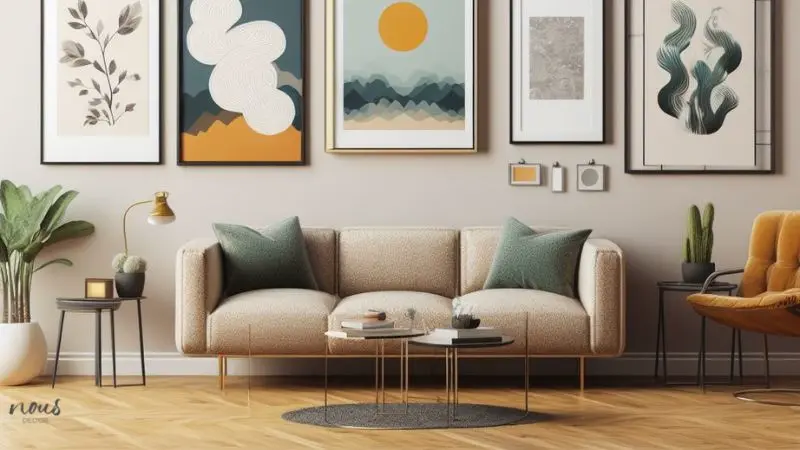
Playing with Different Arrangement Styles
Get ready to explore ways to create different layouts such as asymmetrical or symmetrical arrangements that will make your wall art truly pop! Mixing textures and layering styles can create a dynamic look that draws the eye in.
- Try combining a textured tapestry with sleek, modern frames or layering smaller pieces over a larger statement piece for added depth. Don’t be afraid to mix and match styles – eclectic arrangements like quirky mixed-media pieces can be some of the most interesting.
- Using frames creatively is another way to up your wall art game. Consider painting frames in bold colors or patterns, or using unconventional materials like reclaimed wood or metal. Frames don’t always have to be uniform either – try grouping mismatched frames together for an artsy vibe.
- And don’t forget about incorporating lighting – adding small spotlights above or below certain pieces can highlight them and create dramatic shadows.
When it comes to arranging art or photo walls, there are endless possibilities for creativity and individuality. By mixing textures, layering styles, using frames creatively, and incorporating lighting, you can create a unique view that reflects your personality and style.
Hanging Wall Art Correctly & Safely
Make sure your cherished pieces are securely hung and protected by following these expert tips for proper presentation.
- First, ensure you have the proper tools to hang art for your space. These include measuring tape, level, hammer, and nails. Alternatively, you can choose anchors if you are hanging heavy pieces or when dealing with a concrete wall.
- Secondly, avoid common mistakes that can lead to damage or accidents. One mistake is to consider using adhesive hooks or adhesive strips instead of using nails or picture hangers. Furthermore, when selecting hanging hardware, consider the weight of the art pieces.
- Additionally, unconventional wall hangings such as hanging multiple pieces too close together can cause them to look cluttered rather than artfully arranged.
- Finally, when it comes time to hang your art or photo gallery, take care of the placement and arrangement of each piece. Use a level to ensure each piece is straight and properly aligned with others in the grouping. You should also avoid hanging your art too high on the wall and hang artwork at eye level.
- Consider spacing between pieces for a cohesive look that allows each piece to stand out on its own while still being part of a larger display.
With these tips in mind, you can confidently display your favorite artwork for all to enjoy without worrying about safety or damage issues.

Tips for Arranging Wall Art
When arranging art, there are several tips to keep in mind:
- Living room: Arranging art in the living room can be a great way to add personality and style to your space. To decorate walls with pictures, start by considering the size of the wall and the available space. If you have a small wall space, consider using wall anchors to hang your pictures securely. Another idea is to hang three pictures in a row or create groups of pictures to create a gallery effect.
- Bedroom: When arranging decor in your bedroom, consider the size and scale of the pieces. A general rule of thumb is to choose artwork that is proportional to the size of your wall and furniture. Hang larger pieces at eye level to draw attention from viewers, and group smaller pieces together to create a gallery wall. Another tip is to mix different sizes, colors, and textures to add visual interest. Finally, take into consideration the overall theme and style of your bedroom when selecting artwork to ensure a cohesive and harmonious look.
- Large Wall: On a large wall, consider grouping multiple pieces together to create a centerpiece. Start with the largest piece in the center and then arrange smaller pieces around it. Play with different layouts and spacing to find what looks best in the space. You can also consider using mirrors or shelves to break up the wall and add variety. Don’t be afraid to experiment and have fun with your arrangement to create a unique and visually appealing view.
And don’t forget to display art in other areas of your home, such as the kitchen or bedroom, to bring the same decorative touch to those spaces.
Frequently Asked Questions
Conclusion
So there you have it, folks! We’ve covered everything from choosing the right wall for your art collection to hanging your artwork correctly and safely. By mastering the art of arranging art on walls, you can transform any room in your home into a beautiful space that reflects your personal style.
Remember, when looking for hanging artwork ideas, consider creating a focal point with a statement piece and balancing colors, sizes, and shapes. Don’t be afraid to take your time and play around with different arrangement styles until you find the perfect one for you.
With these tips and tricks in mind, you’ll be well aware of How to Arrange Wall Art that will leave all of your guests in awe with your collection of art in the kitchen wall or living room. Happy decorating!

